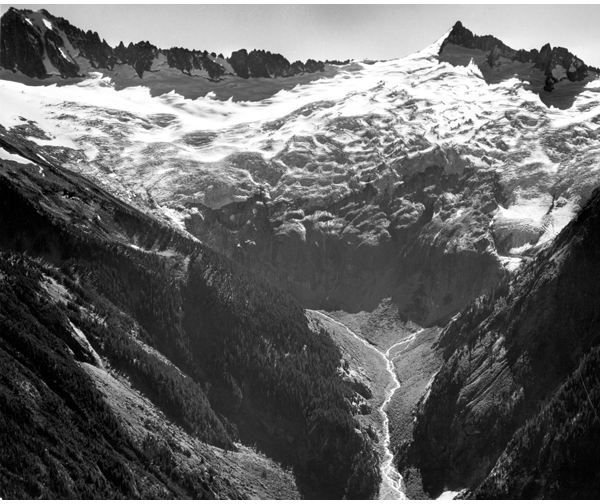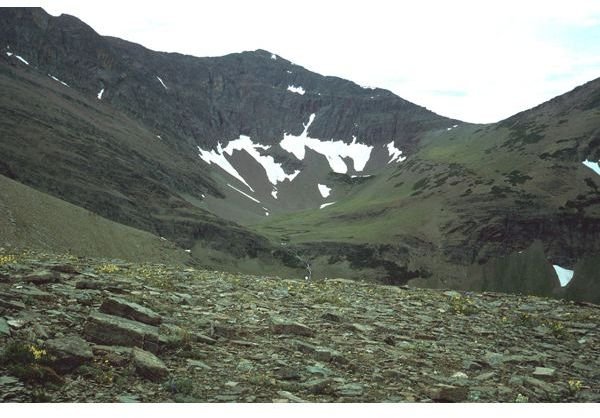Corries Glaciation – Landforms and Climate Change
A corrie, more commonly called a cirque, is a bowl-shaped depression carved out of the side of a mountain by a glacier. As ice accumulates in a small depression, it erodes the rock away, increasing the size of the depression and allowing more ice to form – a glacier is born. Cirque glaciers are one of the main glacier types, and are the smallest. They grow over time and eventually flow off the side of the cirque into valleys where they join with or form new valley glaciers. The image below (left) shows a classic cirque formation on Mount Henry in Glacier National Park, Montana. Boston Glacier (center) resides in a large cirque in North Cascades National Park, Washington.
Corrie Glaciation Images


Related Glacial Structures
Corrie glaciation, although small, is a complex process of accumulation, ablation, and erosion. As glaciers grow, they grind away at the mountain creating not only cirques, but also a variety of glacial formations. When two cirques form on opposite sides of a ridge, they erode it down to a knife edge, creating the landform known as an arête. When multiple cirques or mountain glaciers erode all sides of a mountain they form a horn. A famous example is the Matterhorn. The above (right) image shows the glacial horn, Mount Stimson, in Glacier National Park, Montana. An arête extends to the left of the horn and three cirques are visible below.
Sometimes cirques fill with water creating tarn lakes. A series of tarns stepping down the valley are paternoster lakes. These lakes connect with a single narrow stream, giving the effect of beads on a string. Although they may begin in cirques, paternosters typically form beneath valley glaciers when the valley floor erodes unevenly due to varying rock types. Harder materials are more resistant to the glacier’s forces and softer materials give way more easily. As in washboard ripples or potholes in roads, the depressions grow over time. Ridges of glacial deposits also form dams along the valley floor to create paternoster lakes.
As glaciers grow, they pick up and carry debris from the mountain. This poorly sorted glacial sediment known as till is deposited to form moraines when glaciers recede. Moraines are found in cirques as well as valleys and come in lateral, medial, ground, and terminal varieties, depending on their orientation and position in relation to the glacier.
Mass Balance
All glaciers change in size over their lifetime. Seasonal changes occur as well as long-term changes as ice ages come and go. The change in mass of a glacier or part of a glacier over time is called mass balance. Mass balance measurements provide a way to quantify glacial change both seasonally and over longer periods. These measurements are particularly important now, in the face of global climate change.
Glaciers grow and shrink with two main process types, accumulation and ablation. Accumulation is any processes adding to the mass of a glacier, while ablation is any process causing loss of mass. Examples of accumulation are snowfall, windblown snow, accumulation of ice crystals from freezing rain, and avalanches. Examples of ablation are melting, calving, sublimation, and wind scouring.
Climate Change and Glaciers
Worldwide, glacier ablation rates are exceeding accumulation rates and glaciers are receding. The glaciated ranges of the Andes, Alps, Himalayas, Rocky Mountains, and North Cascades are all undergoing significant loss in glacial mass balance. Some glaciers have already disappeared and models predict the disappearance of many more within the century. That glaciers are retreating at a global scale is one of the primary factors proving that global warming is occurring, and not just an artifact from rising city heat island temperatures.
However, there is great variability in how climate change affects glaciers. Small cirque glaciers typically respond first. Large valley glaciers see less impact from minor temperature shifts and have longer response times than small glaciers. Variables other than size play a role in how glaciers respond to climate change. The slope of a glacier makes a difference in its response to climate change; steeper glaciers tend to show less response than horizontal glaciers. Perhaps this is because there is more area for sublimation to take place on shallow slopes than on steep slopes. Even with these generalizations about size and slope, responses of individual glaciers are highly variable and difficult to predict due to complexities of their environmental conditions.
Consequences of Glacial Retreat
The retreat of glaciers can lead to landslides and flooding events. Previously glaciated slopes become unstable when the ice is gone, and without vegetation slopes are even more susceptible to landslides. Rapid release of water from the glacial melting can lead to glacial lake overflow and flash floods downstream.
In addition to catastrophic events, glacial retreat causes numerous problems related to the flow level of streams and rivers. For a time, there is more melt water causing flooding and disruption of ecosystems and cities. However, as glaciers diminish, each warm season brings less melt water, causing flow levels to decrease or dry up completely.
Glacial melt feeds many rivers, maintaining flow through dry seasons. This is the case for many rivers in mainland Asia, which provide water for China, India, and other parts of Asia. Many cities depend on this glacier-sourced water during dry seasons. When these glaciers disappear, so will the primary dry season water source for some of the world’s most populated cities.
Global Warming and Corrie Glaciation
Ice ages come and go through geologic history, and glaciers form and dissapear without any human influence. However, the recent rapid release of carbon from fossil fuels for the production of municipal power and heat, as well as the release of other greenhouse gasses due to technological advancements, has artificially induced warming that would not have occured naturally. This warmning has broad implications for the planet, including the dissapearance of glaciers. Corrie glaciers are the first to develop and now, it appears, the first to retreat as global temperatures increase.
Refrences
Brown, J., et al.(2010) “Cirque Glacier Sensitivity to 21st Century Warming: Sperry Glacier, Rocky Mountains, USA” Global and Planetary Change. 74: 2, 91-98.
Chinn, T. J.(1996) “New Zealand Glacier Responses to Climate Change of the Past Century” New Zealand
Journal of Geology and Geophysics. 39: 3, 415 - 428.
Chinn, T.J.(Nov 1999) “New Zealand Glacier Response to Climate Change of the Past 2 Decades” Global and Planetary Change. 22 155–168.
Climate Change and Global Warming Fact Sheet, Retreat of Glaciers Due to Global Warming.
Hansen, J., et al.(Sep 2006) “Global temperature change” PNAS 103: 39 14288–14293.
Photo Credits:
Carrara, P. USGS Photographic Library, photo car00544. July 17, 1983.
Carrara, P. USGS Photographic Library, photo car00271. July 3, 1979
Post, A. USGS Photographic Library, photo post0005. 1971.
